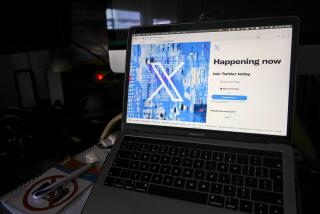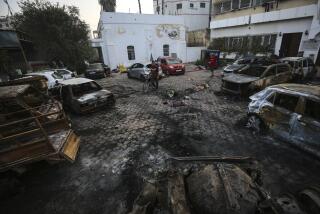Twitter in the time of Sandy: A few lies, and then redemption
There was a time last week, as super storm Sandy bore down on New York City and the rest of the Eastern Seaboard, when Twitter became the face of evil.
It was a popular, nameless and faceless political account named @ComfortablySmug that stirred up the trouble -- with its anonymous owner tweeting blatantly incorrect information that confused many New Yorkers during the height of the storm on the night of Oct. 29.
“BREAKING: Con Edison has begun shutting down ALL power in Manhattan,” @ComfortablySmug tweeted emphatically, and falsely.
“BREAKING: Governor Cuomo is trapped in Manhattan. Has been taken a secure shelter,” @ComfortablySmug insisted.
“BREAKING: MTA announces NYC subways will be closed for remainder of the week. All major lines are flooded and will require repair,” @ComfortablySmug said — a lie that came close enough to the truth to get retweeted more than 500 times.
Yet a lie it was, and by the time daylight came to Manhattan, viral news site BuzzFeed had unmasked @ComfortablySmug as Shashank Tripathi, a Republican congressional campaign manager in New York who quickly resigned with shame and without explanation.
The @ComfortablySmug affair -- as well as all the fake viral photos on Facebook that accompanied the storm’s arrival, suckering many professional reporters -- provoked much hand-wringing about the reliability of social media in the time of crisis and prompted articles like Gawker’s “Twitter Is a Dangerous Lie Generator, Not a Truth Machine.”
But as the floodwaters receded along with the furor over @ComfortablySmug, another -- arguably more important -- social media story was developing in Chelsea, half a block from the Hudson River. That story would in lesser degrees repeat itself over Manhattan, Staten Island and the Rockaways in the coming days of recovery, where information repeatedly won out over worries of ongoing, anonymous hysteria.
The story was this: The Ali Forney Drop-In Center filled up with four feet of water.
A lot of places in Manhattan got hit pretty hard, but there was reason to be especially concerned about this 1,200-square-foot office: It served New York’s homeless LGBT teenage population – the fringe of the fringe, kids turned out from home for being gay, kids who had to sleep on subways and sometimes turn to prostitution when they didn’t have a place to stay at night.
The drop-in center was ruined, its floors buckled, its electrical outlets filled with sea salt. So Ali Forney founder Carl Siciliano put out a call for help on Facebook.
Then a popular gay blogger named Joe My God picked up the message and ran with it.
And then Twitter – specifically, the people on it -- ran with it.
Pam Grier tweeted the news to hundreds of thousands of followers, Joseph Gordon-Levitt tweeted it to hundreds of thousands more, and in less than 24 hours, the Ali Forney Center had received more than 900 donations totaling $100,000, Siciliano said in an interview Sunday evening.
“We’ve never had a day where $100,000 came in online before,” he told the Los Angeles Times. “That’s actually kind of phenomenal. And it shows the power of social media to do good.”
Although LGBT youth had historically been marginalized by traditional, mainstream institutions, Siciliano said, now the community could rally around those needing help the most. And social media helped make it happen, allowing people to help each other without waiting for someone else to tell them what to do.
The trend radiated from Manhattan toward New York City’s outer boroughs, toward Staten Island and toward the Rockaways in Queens, where some of Sandy’s worst destruction occurred. Social media did not act like a dangerous lie generator. It acted like something that wanted to save somebody’s life.
Although the technology is new, the social phenomenon isn’t. In the book “A Paradise Built in Hell,” Rebecca Solnit wrote about disaster survivors’ tendency to band together and organize among themselves rather than dissolve into total chaos and anomie. The grisly aftermath of Hurricane Katrina turns out to be not the norm, but the aberration -- which Solnit, a leftist writer, blames on the “elite panic” of government officials who fear public reaction, hide information and try to regulate survivors too much and too soon after a disaster.
It’s a sociological theory, and one that New York City seemed to bear out in the aftermath of this storm. Rather than waiting for a press release from Mayor Michael R. Bloomberg or for the arrival of the Red Cross, New York City’s social media users have been telling each other what they need -- sometimes tweeting photos of supply wish-lists for help stations and organizing rides among strangers, at other times openly begging for help in an area neglected by officials.
When Reuters social media chief Anthony De Rosa wanted to head to the Rockaways to pitch in with the relief effort, he asked if somebody could give him a ride. And somebody did: two followers he’d never met, who helped ferry him and several other volunteers to the ruined edge of Queens.
“Being able to get that van ... was pretty mind-blowing for me, because it’s really difficult to get any transportation out to these areas, especially a large vehicle,” De Rosa told the Los Angeles Times. He added that Twitter was particularly useful for requesting specific supplies in specific places -- needs that change quickly.
“Twitter’s been a really good outlet for relaying that information to certain areas and making certain runs back and forth,” he said. The supplies most needed are not always the ones most often provided: shovels and baby supplies, boots and detergent.
Social media is far from a cure-all, though. The artist Molly Crabapple said phone coverage in her Wall Street apartment disappeared with the power when the storm hit Manhattan, putting communication back in the face-to-face era. When she was able to get back on social media, she began to sell paintings and raised $1,500 for relief efforts – she advertises solely through social media. But coverage disappeared again when she and a friend took a burger truck out to the Rockaways to hand out food and help survivors.
“When you’re actually there, social media is a little limited,” she said, but it excels at organizing people.
On the scene of a disaster, she added, “You still need to go up to people and say, ‘Hi, how can I help,’ face-to-face.”
The tweets and Facebook messages for help continued through Sunday night -- can somebody give me a ride here, can anybody bring warm clothes over there?
@ComfortablySmug, meanwhile, never faced anybody.
After his outing, he tweeted a four-paragraph apology without signing his name. Then, unlike the rest of New York, and unlike the service he spurred others to malign, he faded away with the storm.
More to Read
Start your day right
Sign up for Essential California for news, features and recommendations from the L.A. Times and beyond in your inbox six days a week.
You may occasionally receive promotional content from the Los Angeles Times.







